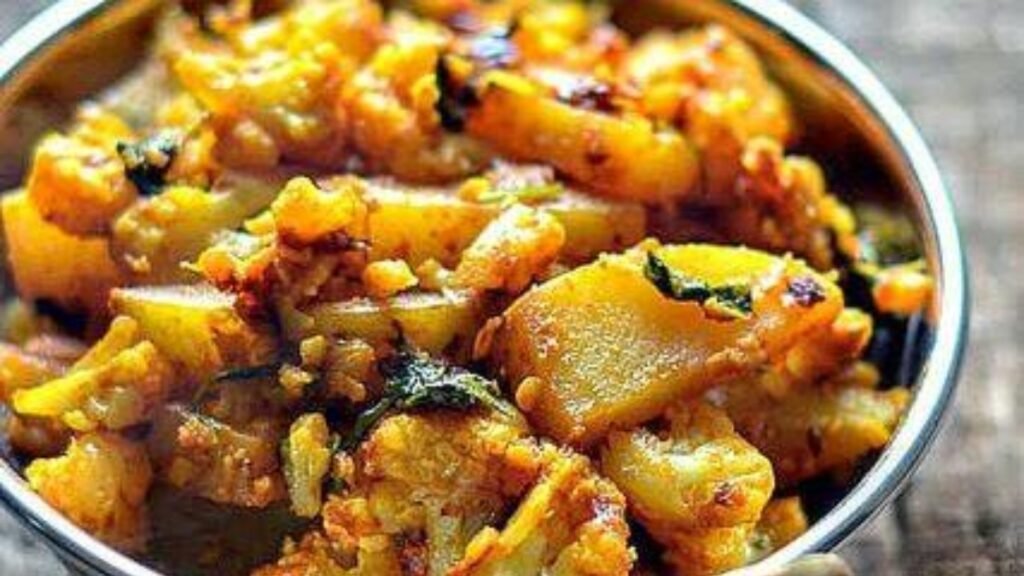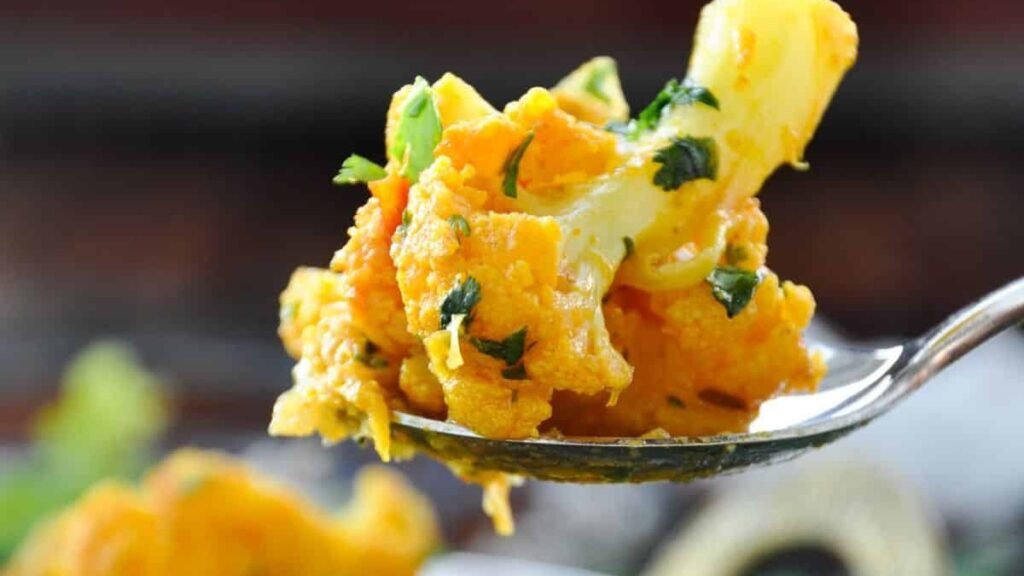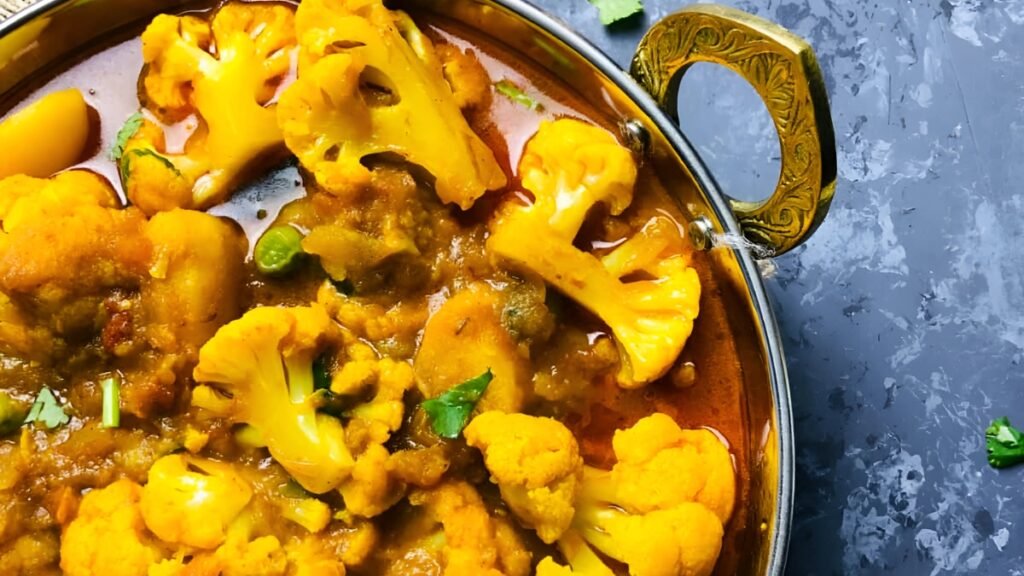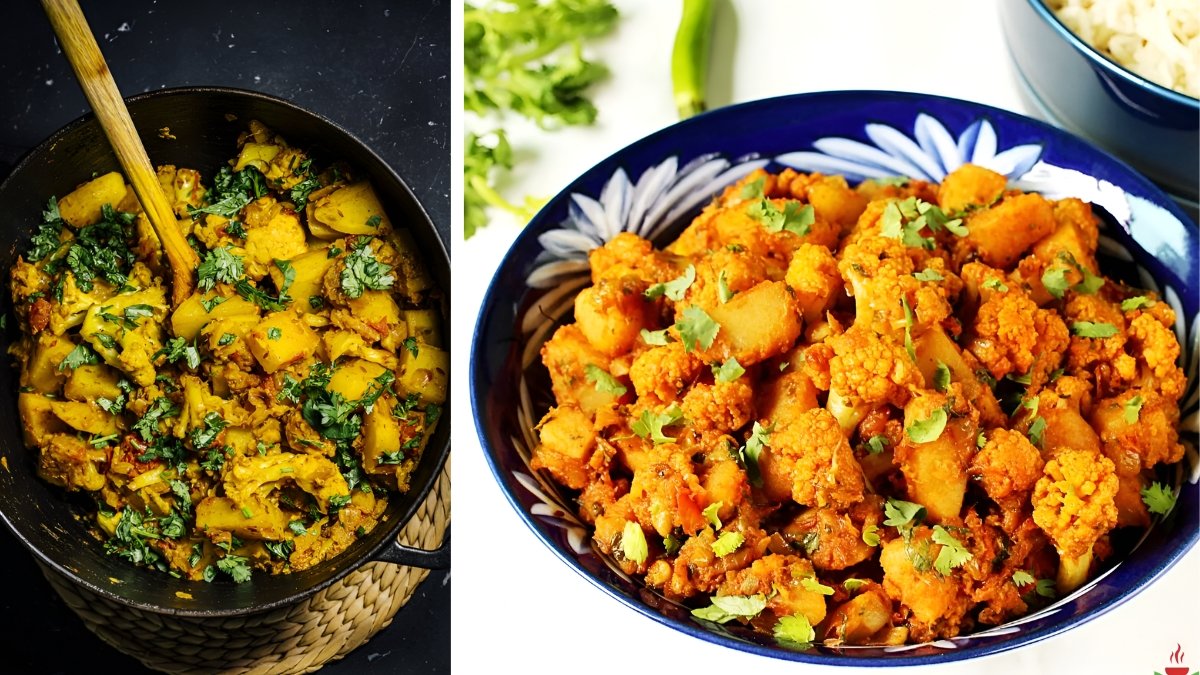If you love Indian home-cooked food, Aloo Gobi Dry Curry is one dish you can’t miss. This simple potato and cauliflower stir-fry packs a burst of flavor and comfort in every bite.
Whether you’re a beginner or a busy foodie who wants something quick and tasty, this 5-step Aloo Gobi recipe will become your go-to weeknight meal. Let’s get started!
What Exactly Is the Aloo Gobi Dry Curry?

Aloo means potatoes and Gobi means cauliflower two humble veggies that come together beautifully in this dish.
Unlike the gravy version, Aloo Gobi Dry Curry is a dry-style stir-fry, cooked with Indian spices, onions, and tomatoes until everything turns slightly crispy and aromatic.
It’s a classic North Indian comfort food that goes perfectly with roti, paratha, or even plain rice.
What Is the Best Time to Make Aloo Gobi Curry and Why It Matters
The best thing about this dish? You can make it any time of the year. But it’s especially comforting during cooler months when cauliflower is in season (from November to February).
Using fresh, firm cauliflower florets gives you that perfect texture soft inside and slightly roasted outside. Plus, the potatoes absorb all the spices, making every bite deliciously warm and hearty.

How Aloo Gobi Dry Curry Works – Explained Simply
Cooking Aloo Gobi is all about balance soft potatoes, tender cauliflower, and the right mix of spices. Let’s walk through it step by step:
Step 1: Gather Your Ingredients
You’ll need:
- 2 medium potatoes (peeled & cubed)
- 1 small cauliflower (cut into florets)
- 1 medium onion (sliced)
- 1 tomato (chopped)
- 1 tsp cumin seeds
- 1 tsp ginger-garlic paste
- ½ tsp turmeric powder
- 1 tsp red chili powder
- 1 tsp coriander powder
- Salt to taste
- 2 tbsp oil
- Fresh coriander leaves for garnish
Step 2: Heat Oil and Add Aromatics

In a pan, heat oil and add cumin seeds. Once they splutter, add sliced onions and sauté until golden brown.
Add ginger-garlic paste and fry for another 30 seconds until fragrant. This forms the base of your curry’s flavor.
Step 3: Add Tomatoes and Spices
Toss in the chopped tomatoes and cook until they turn soft and mushy. Add turmeric, chili powder, coriander powder, and salt.
Cook for 2–3 minutes this masala will coat your veggies later and give the dish its signature taste.
Step 4: Add Potatoes and Cauliflower
Now add the cubed potatoes and cauliflower florets to the pan. Stir well to coat them in the spice mixture.
Cover with a lid and let it cook on low heat for 10–12 minutes. Stir occasionally so it doesn’t stick or burn. You’ll know it’s done when both veggies are tender but not mushy.
Step 5: Finish and Garnish
Once cooked, remove the lid and cook uncovered for another 2–3 minutes to crisp things up. Sprinkle garam masala and fresh coriander leaves on top.
Your Aloo Gobi Dry Curry is ready to serve! Enjoy it with warm chapatis or rice.
What’s the Secret to a Perfect Aloo Gobi Dry Curry?

The secret lies in timing and moisture control. You don’t want it too dry or soggy.
Here’s a quick comparison to help you get it right:
| Common Problem | Why It Happens | How to Fix It |
|---|---|---|
| Soggy texture | Too much water or steam | Cook uncovered for last 5 mins |
| Hard potatoes | Not pre-cooked enough | Steam potatoes slightly before adding |
| Burnt bottom | High flame or no stirring | Keep on low-medium heat, stir often |
What They Are – The Spices That Make Aloo Gobi Irresistible
Indian spices make this dish shine! Here’s a quick breakdown of what they do:
| Spice | Flavor Profile | Purpose |
|---|---|---|
| Turmeric | Earthy, warm | Adds color & depth |
| Red chili powder | Spicy | Gives heat & kick |
| Coriander powder | Citrusy | Balances flavor |
| Garam masala | Aromatic blend | Adds warmth at the end |
These spices don’t just season the dish they create that irresistible aroma that fills your kitchen.
Common Mistakes With Aloo Gobi and How to Avoid Them
Even simple dishes have traps! Here are a few common ones:
- Overcrowding the pan: This traps steam and makes veggies soggy.
- Skipping the stir: Stir every few minutes to cook evenly.
- Adding water: Avoid it unless the veggies start sticking.
- Overcooking: Soft cauliflower ruins the texture. Stop when tender!
Best Tips to Make the Most of Aloo Gobi Curry
- Use mustard oil for a traditional North Indian flavor.
- Sprinkle amchur powder (dry mango powder) at the end for a tangy twist.
- Add green peas if you want extra color and sweetness.
- For meal prep: Cook it in the morning, reheat on low before serving it tastes even better later!
Conclusion
And that’s it your easy 5-step Aloo Gobi Dry Curry recipe!
It’s simple, quick, and full of everyday Indian flavors. Whether you’re new to Indian cooking or just looking for a reliable comfort dish, this one’s a winner every time.
Try it once, and it’ll find a permanent place in your weekly meal rotation.
FAQs About Aloo Gobi Dry Curry
1. When should I cook Aloo Gobi before or after boiling the vegetables?
No need to boil! Cook raw potatoes and cauliflower together on low heat they’ll become tender without losing texture.
2. What is the best oil for making Aloo Gobi?
Mustard oil or sunflower oil work best. Mustard oil gives an authentic Indian flavor.
3. Why does my Aloo Gobi turn mushy?
That happens if you add water or cover it for too long. Always cook uncovered in the last few minutes.
4. How can I make Aloo Gobi healthier?
Use minimal oil and steam-cook the veggies first. You can also air-fry them lightly before mixing with spices.
5. Can I store leftover Aloo Gobi Curry?
Yes! Keep it in an airtight container in the fridge for up to 2 days. Reheat on a pan before serving.
